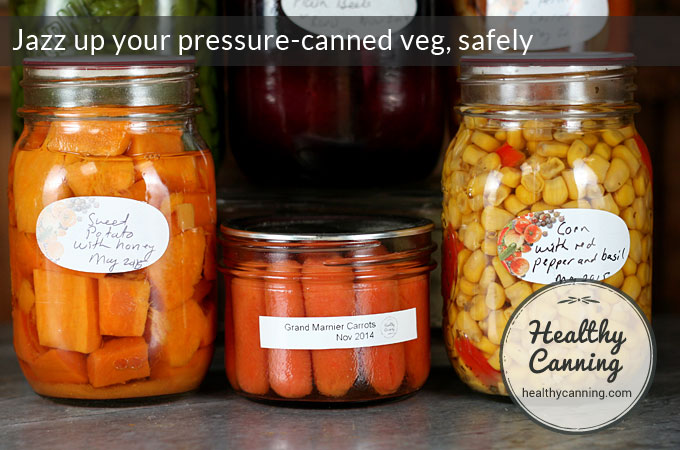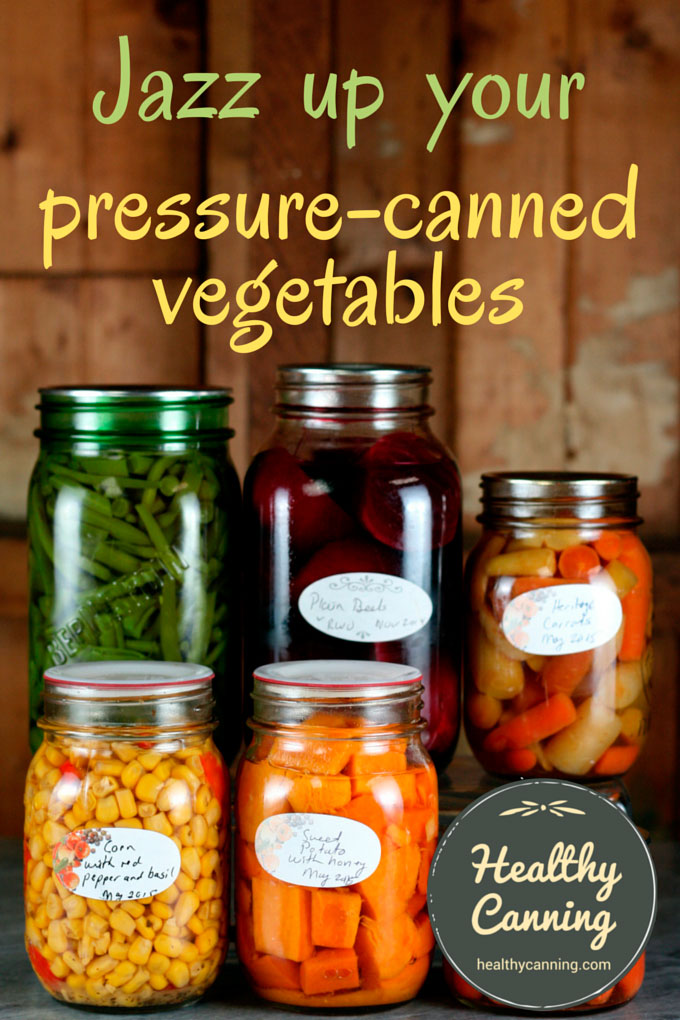There are easy ways to safely jazz up your pressure canned vegetables and still remain within the vital safety guidelines set by the USDA.
Safe tweaks for home-canned produce
Depending on the vegetables (carrots, green beans, tomatoes, beets, etc) that you are pressure-canning, you may wish to consider adding any of the following to your jars:
- Asparagus: a few sprinkles of lemon zest per half-litre (1 US pint) jar. [1]Based on Ball Blue Book, 36th edition. Muncie, Indiana: Healthmark LLC / Jarden Home Brands. Suggestion for green beans, page 77.
- Beets: a bay leaf or two. [2] van Delden, Kari. Add Variety to Home-Canned Fish. University of Alaska Fairbanks Cooperative Extension Service. FNH-00224. Revised April 2012. https://www.uaf.edu/files/ces/publications-db/catalog/hec/FNH-00224.pdf
- Carrots: a bay leaf or two, orange zest, some orange juice [3]Ball Blue Book, 36th edition, page 77., some Grand Marnier, Cointreau or Triple Sec. Say, 1 to 3 tablespoons per ½ litre (1 US pint) jar.
- Corn: per ½ litre (1 US pint) jar, ½ teaspoon dried basil and 3 to 4 thin strips of red pepper. [4]Ball Blue Book, 36th edition, page 77.
- Green beans: a bay leaf or two, a few sprinkles of lemon zest or a thin strip or two of lemon peel (white pith removed). Ball says “narrow strips”, no indication of exact width. [5]Ball Blue Book, 36th edition, page 77. Consider combining green and yellow beans in the same jar for a particularly attractive appearance.
- Mushrooms: a bay leaf or two, a tablespoon or two of a booze such as vermouth or brandy.
- Peas: per ½ litre (1 US pint) jar, ¼ teaspoon each of dried, ground chervil and thyme. [6]Ball Blue Book, 36th edition, page 77.
- Peppers: 1 ½ teaspoons vinegar to each quarter-litre ( ½ US pint jar); 3 teaspoons vinegar to each ½ litre (1 US pint) jar. [7]Bernardin Guide, 2013, page 104. Consider combining pieces of differently coloured peppers in the same jar for a particularly attractive appearance.
- Sweet potatoes: add 1 to 2 tablespoons of honey per ½ litre (1 US pint) jar. [8]Ball Blue Book, 37th edition. Muncie, Indiana: Healthmark LLC / Jarden Home Brands. Page 115.
- Tomatoes: 1 bay leaf, 1 basil leaf [9]Ball Blue Book, 37th edition, page 33., If you want more of a basil flavour than that, add some dried basil instead, or as well, leaving the single bay leaf in for decoration.
Pressure canning mixed vegetables
You can pressure can any custom mix of vegetables you desire, provided that:
- There is an approved processing time for each vegetable (so, no to cabbage, for instance); and
- You process the mixture for the time required by the vegetable with the longest processing time for that size of jar.
Barb Ingham at the University of Wisconsin says,
You may create vegetable mixtures as long as there is a tested recipe for each vegetable that you are combining and you follow the processing time for the vegetable that has the longest time listed.” [10]Ingham, Barb. Play it safe when preserving vegetables. 29 June 2015. Accessed June 2015 at https://fyi.uwex.edu/safepreserving/2015/06/29/safe-preserving-play-it-safe-when-preserving-vegetables/
The Ball Blue Book gives the following rule of thumb for doing this:
The length of processing time for combination recipes must safely preserve the ingredient requiring the longest processing time. Follow individual recipe for ingredient preparation, jar size and processing time.” [11] Ball Blue Book, 37th edition, page 98.
For more information, see Mixed Vegetables.
General seasonings for pressure-canned vegetables
Lemon-zest
A “few sprinkles” of lemon-zest. That means about ⅛th to ¼ teaspoon; you wouldn’t want much more than that taste-wise anyway.
Dried herbs
Dried herbs are safe to add in small quantities to pressure canned foods; indeed to water-bathed savoury preserves as well. See “Home Canning with Herbs.”
Bay leaves
A bay leaf is very nice tucked into a jar of vegetables to be pressure canned. (One or two people have said they consider a bay leaf flavour too strong for them; they may not have been using real bay leaves, see separate entry on Bay Leaves.)
Garlic
Barb Ingham at the University of Wisconsin says it’s fine to add 1 clove of garlic per jar, if desired: “You may add a small amount of garlic (up to 1 clove per jar) to canned vegetables without impacting the processing time.” [12]Ingham, Barb. Play it safe when preserving vegetables.
Sage
Sage is generally reported to have too strong a taste after pressure-canning. The report emerged by 1936, but there’s no record of anyone actually trying it since then. See “Can you use sage in home canning?”
Alcohol
When you use alcohol for flavouring, such as Grand Marnier or Cointreau with carrots, no alcohol will likely actually survive, because sadly alcohol evaporates before water even, but, it’s the concentrated flavour you are after. Don’t go nuts with the alcohol. The suggestion here is not for half a mason jar of booze; at most 1 to 2 to 3 tablespoons per ½ litre (1 US pint) of food product, only for flavouring. Instead of alcohol, you could try a tablespoon or two of lime juice if canning tomatillos or jalapeno peppers, or of lemon juice for other vegetables such as bell peppers, etc. Note that that quantity of citrus juice has zero preservative capability in pressure canning and is for flavour only. Note though that citrus juices (lime, lemon or orange) may cloud the water inside the jars somewhat. This is the advantage of clear liqueurs such as Grand Marnier and Cointreau, which impart flavour invisibly.
Aside from their Red Onions in Honey and White Wine recipe, [13] Ball Blue Book, 37th edition, page 116, Ball generally steers clear of even a drop of alcohol in their pressure canning. Perhaps this is not surprising, given the Baptist etc. religious background of customers they would have served in the American south. Bernardin is a bit more liberal in its use of alcohol as an ingredient, which also is perhaps not surprising given the French background in Canada.
Notes
Note that aromatic vegetables such as celery and onion aren’t on any authorities list of what you can just add as “optional list” flavouring. Nor are fresh herbs.
When trying a bit of lemon zest, dried herb, or cinnamon stick in a home canned food product for the very first time, consider trying it in just one or two jars, and in very light quantities. Putting Food By says,
Where flavorings usually included in such recipes are omitted, it is because some herbs and spices produce an unwanted taste after pressure-processing… Use your seasonings lightly because such flavorings change during canning and storage.” [14] Hertzberg, Ruth; Greene, Janet; Vaughan, Beatrice (2010-05-25). Putting Food By: Fifth Edition (p. 182 & 194). Penguin Publishing Group. Kindle Edition.
The reaction of the safe canning police to such suggestions above will vary. You will get ideologically rigid, and you will get reasonable.
Rigid
Penn State Extension says,
A client called and wanted to know if he could can meat with a more tender result by adding some red wine vinegar in place of all water for the liquid… although adding vinegar will not make this product become unsafe, we do not recommend that consumers modify the recipes in the USDA Complete Guide to Home Canning.” [15] Penn State Extension. Canning Meat With Added Vinegar. Accessed January 2015 at https://extension.psu.edu/food/preservation/faq/canning-meat-with-added-vinegar
With respect, it could be thought that it’s that kind of knee-jerk negative response about something which is patently safe that could be responsible for many people giving up on the authorities and turning to Wild West canning sources.
The refrain of government agents is “don’t get creative”, but it’s futile: throughout history preserves have always been used as a creative outlet, and you aren’t going to change that.
Like so many other art forms preserving — in either, salt, sugar or vinegar — was born out of necessity but was then transformed by imagination into a means of self expression and pride for housewives who had few other creative outlets. Preserving the harvest became an often competitive outlet for wives as they vied against each other in local fairs showing others their prowess in the kitchen.” [16] Brown, Marion. Pickles and Preserves. North Carolina: University of North Carolina Press. 2002. Foreword.
A more reasonable approach seems to be to provide safe outlets for the creativity, because it won’t go away with the wag of a bony finger. When it comes to population health, the modern thinking is that a harm reduction approach is often best.
Reasonable
A Kansas State Extension Agent says,
You can typically change spicing…. ” Karen Blakeslee, Food Scientist and Kansas State Extension Agent. [17] Karen Blakeslee, Food Scientist and Kansas State Extension Agent. Quoted in: Mather, Robin. Are Old Canning Recipes Safe to Use? Mother Earth News. May 2012. Accessed March 2015 at https://www.motherearthnews.com/real-food/canning-recipes-zb0z1205zmat.aspx
Utah State Extension gives a list of things that people can vary: [18] Brennand, Charlotte P., “Food Canning-Major Canning Sins” (1999). Food and Health. Paper 31. Utah State Cooperative Extension Service. https://digitalcommons.usu.edu/extension_histfood/31. Page 4.
Exceptions to the rule of never change anything in a canning recipe.
Feel free to:
- Change salt level in anything except [ed: fermented] pickles.
- Change sugar level in syrup used for canned fruit.
- Add extra vinegar or lemon juice.
- Decrease any vegetable except tomatoes in salsas.
- Substitute bell peppers, long green peppers or jalapeno peppers for each other in salsa recipes as long as you do not increase the total amount.
Ball says,
…always follow a USDA tested and approved recipe. You can always add dry ingredients, like dry red pepper flakes, or maybe cinnamon to apple sauce, or maybe something else to add some flavour, but always use dry, using fresh changes the pH…” [19] Jessica Piper. Video: Canning Lids 101. 25:34 . Accessed March 2015 at https://ball.yourbrandlive.com/c/lids/.

Sweet potato with honey; Grand Marnier carrots; Corn with red pepper and basil.
References


Lené
When they say “always use dry ingredients” as a flavor additive, and cite red pepper flakes, I wonder if this means I could add a ts of red pepper flakes and a ts of dehydrated minced onion flakes to a jar of green beans, for example? I know adding fresh onion would be problematic, but small amounts of the dehydrated onion would seem to fall into the same category as the red pepper flakes. Am I mistaken?
Healthy Canning
See safe tweaking: https://www.healthycanning.com/safe-tweaking-of-home-canning-recipes/